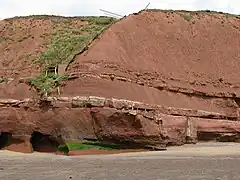Aylesbeare Mudstone Group
The Aylesbeare Mudstone Group is an early Triassic lithostratigraphic group (a sequence of rock strata) in southwest England. The name is derived from the village of Aylesbeare in east Devon. The Group comprises the Littleham Mudstone Formation, the Exmouth Mudstone and Sandstone Formation and the underlying Clyst St Lawrence Formation. The strata are exposed on the coast between Exmouth and Budleigh Salterton where the type section is defined.[1] The rocks of the Aylesbeare Mudstone Group have also previously been known as the Aylesbeare Group and the Aylesbeare Mudstone Formation.[2]
| Aylesbeare Mudstone Group | |
|---|---|
| Stratigraphic range: | |
 | |
| Type | Group |
| Unit of | New Red Sandstone Supergroup |
| Sub-units | Exmouth Mudstone and Sandstone Formation, Littleham Mudstone Formation, Clyst St Lawrence Formation |
| Underlies | Budleigh Salterton Pebble Beds |
| Overlies | Exeter Group |
| Thickness | 400-530m |
| Lithology | |
| Primary | mudstones |
| Other | sandstones, siltstones |
| Location | |
| Region | southwest |
| Country | England |
| Extent | east Devon, Somerset |
| Type section | |
| Named for | Aylesbeare |
Stratigraphy
Exmouth Mudstone and Sandstone Formation
Around 200 - 255m of silty mudstones between the coast near Exmouth north to Aylesbeare, beyond which it is not separately mapped. It includes numerous sandstone lenses which can be up to 30m thick. This sequence has been known by various names in the past including the Exmouth Sandstones, Exmouth Formation and the Exmouth Mudstone and Sandstone Member amongst others. The type section is in the coastal exposures between Exmouth and Straight Point.[3]
Littleham Mudstone Formation
Around 200m of silty mudstone in the Exeter area rising to 275m thickness on the coast between Littleham Cove and Budleigh Salterton (type section). The formation has been mapped northwards from Littleham to the vicinity of Aylesbeare but is not separately distinguished beyond there. This sequence has previously been referred to variously as the Littleham Beds, the Littleham Formation and the Littleham Mudstones.[4]
Clyst St Lawrence Formation
The formation comprises between 30 and 50m of sand and silt, representing weathered sandstone and siltstone, at outcrop between the east Devon hamlets of Westwood and Mutterton.[5]
References
- British Geological Survey 1:50,000 scale geological map (England & Wales) sheet 339 Newton Abbot
- http://www.bgs.ac.uk/Lexicon/lexicon.cfm?pub=AYB (BGS on-line lexicon of rock units)
- "BGS Lexicon of Named Rock Units - Result Details".
- "BGS Lexicon of Named Rock Units - Result Details".
- "BGS Lexicon of Named Rock Units - Result Details".